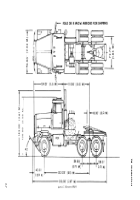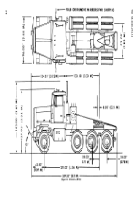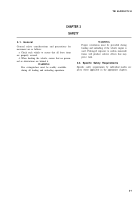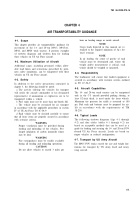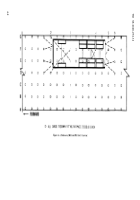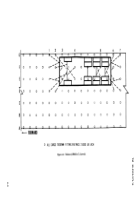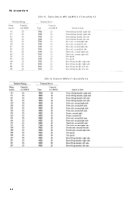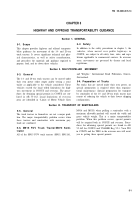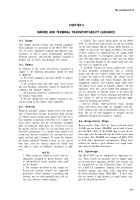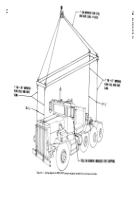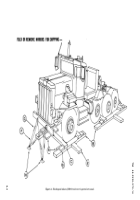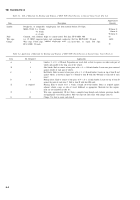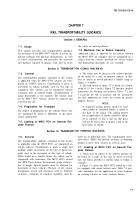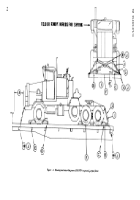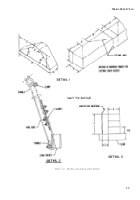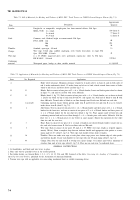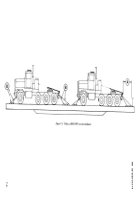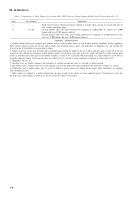TM-55-2320-273-14 - Page 23 of 40
TM 55-2320-273-14
CHAPTER 6
MARINE AND TERMINAL TRANSPORTABILITY GUIDANCE
6-1. Scope
This chapter provides marine and terminal transporta-
bility guidance for movement of the M915 FOV vehi-
cles. It covers significant technical and physical char-
acteristics, as well as safety considerations, prescribes
blocking materials; and provides guidance required to
prepare, lift, tie down, and discharge the vehicles.
6-2. Safety
In addition to the safety precautions contained in
chapter 3, the following precautions should be taken
as applicable.
a.
All vessel equipment and gear should be inspect-
ed prior to use.
b.
All stevedore slings and other items used in load-
ing and discharge operations should be inspected for
condition and adequate capacity.
c. All personnel should be cautioned not to work un-
der vehicles being lifted.
d.
All lifts should have two taglines attached to con-
trol the swing of the vehicle while suspended.
6-3. General
Whenever possible, vehicles should receive the protec-
tion of below-deck stowage. In general, good stowage
of vehicles means having them placed fore and aft as
close together as practical, with about 4 to 6 inches be-
tween outer vehicles and the sweatboards; breakable
parts are protected; spare parts are stowed in or near
the parent vehicle; brakes are on and brake lever is
wire-tied; transmission is in neutral with control lever
wired-tied; battery terminals are disconnected and
taped; and fuel tank is drained. To secure the vehicles,
the wheels should be blocked in front, in rear, and on
both sides; also, the vehicles should be lashed with
wire rope to chains to bulkhead, stanchions, or pad-
eyes.
NOTES
1. When trucks are loaded on vessels that are
adequately ventilated by power blowers, such
as roll-on/roll-off vessels, gasoline tanks need
not be drained.
2. The methods described in this chapter for
lifting and securing vehicles are suggested
procedures. Other methods of handling and
stowage may be used provided they will en-
sure safe delivery without damage.
a. Lifting.
The correct lifting points on the M915
FOV 14- and 20-ton truck tractors are the two shackles
on the front bumper and the spring saddle and pin as-
sembly on top of the rear spring assemblies. The bodies
of these vehicles are reinforced near the spring saddle
and pin assembly. A rectangular spreader bar, with
steel wire-rope slings attached to front and rear lifting
eyes to preclude damage to the engine hood and radi-
ator (fig 6-1), should be used.
b. Loading.
Vehicles are always loaded onto vessels
in their minimum configuration, that is, reduced
height and side view mirrors folded back or removed
to reduce the width of the vehicle. The vehicles can be
loaded onto landing craft, beach discharge and heavy
amphibious lighters, and landing ships under their
own power or by cranes of adequate capacity (38 tons
minimum). Also, they can be loaded onto seagoing ves-
sels by shoreside or floating cranes or by heavy-lift
ship’s gear. Figure 6-2 shows blocking and tiedown de-
tails. Tables 6-1 and 6-2 list materials and their appli-
cation for blocking and tiedown.
c. Special design.
Roll-on/roll-off ships, landing
ships, and attack-cargo ships are equipped with pat-
ented lashing gear and pre-positioned fittings in the
deck. The use of such equipment is adequate and no
additional blocking and bracing is required.
6-4. Barge-Carrier Ships
Barge-carrier ships such as lighter aboard ships
(LASH) and sea barges (SEABEE) can be used to trans-
port the M915 FOV. If the LASH ship is used, the ex-
haust pipe must be removed and the hatch covers must
be in place. The SEABEE can transport all M915 FOV
in their fully operational configuration, When these
vehicles are moved a great distance over rough water,
they must be blocked and braced.
6-5. Lighterage
The M915 FOV can be transported by lighterage ves-
sels. These vessels are normally used to support logis-
tics-over-the-shore operations (LOTS), The vehicles can
be transported on the following types of light-
ers: LARC-LX amphibian, landing craft mechanized
(LCM-8), landing craft utility (LCU 1466-1646), and
the beach discharge lighter (BDL-MR1).
If these vehi-
cles are moved a long distance in rough waters, they
must be blocked and braced.
6-1
Back to Top

